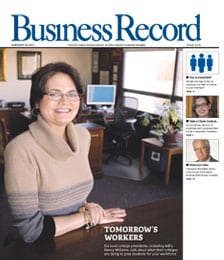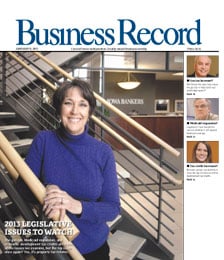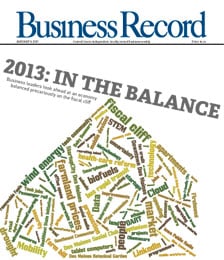2002 in review

Whew. What a year. WorldCom Group, Adelphia Communications Corp., Arthur Andersen LLP, Global Crossing Ltd., Tyco International Ltd., al-Qaeda. Each did its share in contributing to the stock market’s seemingly permanent malaise. Even domesticity maven Martha Stewart’s previously untarnished name was dragged through the mud amid an insider-trading investigation. In a scandal-a-minute environment, investors and investment professionals alike watched in stunned fascination at the confluence of events rocking the financial world. “I’ve been in business since 1976, and I’ve never seen a situation quite like this before,” James Oplt, a senior vice president at UBS PaineWebber in Des Moines, said in July. Few have. The stock market hasn’t declined for three consecutive years since 1939-1941. Corporate misdeeds, an uncertain war on terrorism, lackluster profits and the bursting of the Nasdaq Stock Market’s speculative technology bubble all sapped investors’ confidence. As the bear market wore on, more investors were calling it quits on handling their own financial affairs and turning to professionals for help. Money managers and other financial planners said a record number of potential new clients have been calling or walking through their doors in recent months, anxious for assistance in finding ways to preserve their wealth and stanch the outflow of money from their monthly bank and brokerage statements. The movement, which appeared to have accelerated since the stock market began to dive, marked a sharp contrast to the investor sentiment of two years ago. Back then, white-glove Wall Street brokerage and money management firms that offered expensive advice were forced to slash their rates to compete with brash Internet-based start-ups, such as E*Trade Group Inc. “We’ve had a larger number of new clients come in the door in the past year than ever before in the history of our business,” David Strege, a partner at Syverson, Strege, Sandager and Co. said in August. Worst hit were Americans 65 years and older, who make up 14.9 percent of Iowa’s population, compared with 12.4 percent in the nation as a whole. Dorothy Long, an 80-year-old Windsor Heights retiree, said she grew increasingly fearful as U.S. stock markets continued to struggle. For the past several years, she has lived off investment income, Social Security and a World War II veteran’s pension left by her husband, Harry, who died two years ago. Her portfolio had dropped roughly 21 percent in recent months, and she fretted that the dividends and interest from her investments and payments from other sources wouldn’t be enough anymore. Though she said her income has not fallen, she has been forced to dip into her principal to cover living expenses. “That takes it down pretty fast,” she said in July. “If it goes any lower, I’ll have to get by on quite a bit less.” Long wasn’t alone. More than two years of stock market pain began to pinch those who can least afford to suffer. Americans for years had heard Wall Street’s mantra that socks are the best investment for the longterm, but for retirees, who need the money in the here and now, the longterm was of little consequence. “If I were my kids’ age, I wouldn’t touch anything because I know stocks will come back at some point,” Long said. “It’s difficult to know what to do in the shortterm.” Stockbrokers just shake their heads. “This is the most brutal stretch I’ve ever been through,” stockbroker Kevin McLaughlin said in July. “It’s been very hard.” Charities also felt the slump. The Wellmark Foundation had hoped to attract 100 participants to a workshop in June to help charities and other non-profits shore up their grant-writing skills. Instead, registration was closed when 200 people signed up. Another 200 were turned away. The event’s popularity highlighted an important shift that is happening across Iowa and the nation. As government coffers dwindled, non-profit organizations that have in the past tended to rely on government funding were flocking to alternative sources to find the money they need. “People are really scrambling for dollars,” said Angela Feig, a spokeswoman for the foundation, which gives away about $1 million annually from its $20 million endowment. ADVERTISING SLUMP Among the industries hardest hit by the middling economy was advertising, an important industry in Des Moines. More than 40 companies in Greater Des Moines focus on advertising, public relations and marketing, but few have more than 50 employees. It’s a tough business, made more competitive by a climate in which mergers have caused a decline in the number of large clients. For instance, before DuPont Co.’s $10 billion purchase of Pioneer Hi-Bred International Inc. in October 1999, Pioneer used Meyocks and Priebe of West Des Moines and Texas-based McCormick Co., which has a Des Moines office. DuPont used an East Coast-based agency for its crop-related advertising, but in early 2002, consolidated DuPont’s and Pioneer’s advertising at McCormick. The biggest headlines of the year came from the venerable CMF&Z Marketing and Communications. The agency ushered in a new owner, 3i LLC, a Chicago-based holding company founded by Sean Bisceglia, and a new president, Frank Maher, in January. Maher took over the 36-year-old agency during a time when the industry was suffering from the nationwide economic slump following the Sept. 11, 2001, terrorist attacks. One of his first actions was trimming the workforce by 25, the toughest task he’s ever had to perform. “CMF&Z has been such a great agency, but at that point, because of the economy, it was on a downturn,” he said last spring. “It was awful, but we had to resize the agency to better reflect our clients’ needs. The model the agency was working under was not working, and we knew significant changes had to be made.” CMF&Z had lost several major clients, including Wellmark Blue Cross and Blue Shield, Dow Chemical and the Iowa Department of Economic Development, before Bisceglia purchased it in January as part of a plan to create a marketing and communications giant that would concentrate on business-to-business marketing for agricultural, manufacturing, chemical and technology companies. “The advertising agency in Des Moines is in a state of flux,” Maher told the Business Record in June. “Over the next 24 months, you’ll see some consolidation and you’ll see some agencies falling out of the marketplace.” CMF&Z was one of those agencies. Its Des Moines offices were shuttered at the end of August, the number of employees trimmed from more than 100 when 3i bought it to fewer than 20 when the doors closed for good. The last nine months in the agency’s life were perhaps the most tumultuous in an industry known for its volatility. Plagued by client defections, staff departures and reductions, and promises made empty by a sputtering economy, CMF&Z in September closed the doors of its remaining office in Cedar Rapids. When Bisceglia purchased the agency in January, it was burdened by debt incurred by prior management. The company had lost money for at least two years and meeting debt payments became difficult due to the anemic post-Sept. 11 economy. Clients continued to slash spending, creating the worst advertising agency climate since World War II. CMF&Z was profitable in its last two quarters, but the money needed to recapitalize the company proved too difficult to come by. “The debt was to have been paid off once the financing was finalized,” Maher said. “This was to have been done in February or March. Lo and behold, it was August and the agency still wasn’t recapitalized.” Maher, a former Foote, Cone & Belding executive who also had worked for 7Up, wasn’t out of work for long. In mid-September, he was named president of Denver-based Integer Group’s Des Moines office, replacing Bob Hunderfund, who had been installed as Integer’s president in January. Hunderfund, who had worked for Tampa, Fla.-based WestWayne and Chicago’s Leo Burnett USA, “left the agency to pursue other interests,” according to a statement issued by Integer. Integer has prospered during these tough times for the advertising industry by winning new clients and coaxing more business out of its existing customers. Last year, it won additional work from No. 3 U.S. appliance maker Maytag Corp, which was already one of its biggest clients. Earlier in the year, it was awarded an account worth about $325,000 annually from the Iowa Lottery. Other clients include Pella Corp., Garst Seed Co., Ruan Transportation Management Systems and Holmes Murphy & Associates Inc.. On April 30, Ted Priebe resigned as president and chief executive of the company he founded, Meyocks and Priebe Advertising Inc. The move, which surprised some in the industry, came amid an effort by the agency’s majority owner, Hy-Vee Inc., to move it in a different direction. REAL ESTATE BOOMS Not all industries were losers in 2002. As intrest rates for mortgage loans bumped along at 30-year lows, residential properties around the metro continued to be snapped up at higher prices than ever in the past 50 years. In March, the Business Record reported that the average price for a house in Greater Des Moines rose 5 percent in 2001, and if the first two months of 2002 were any indication, better times were on the way. Near-record-low interest rates helped explain the boom, and as the stock market failed to show strength, investors were increasingly looking at real estate. The rush to home ownership didn’t stop apartment construction, which boomed as well. More apartments were under construction in Greater Des Moines in 2002 than at any time during the past three decades, and apartment vacancies are likely to shoot upward in the coming years as a result, real estate experts said. Over the past 10 years, the Des Moines rental market has been able to absorb roughly 450 new apartment units annually without sparking higher vacancy rates. But in May, more than 1,800 apartment units were either under construction or in the planning stages, according to a survey by Carlson McClure & Associates Inc., which since 1970 has tracked the apartment industry in Greater Des Moines. When the survey was done, the metro area had 20,137 apartment units, and adding another 9 percent in the near future was expected to force a dramatic rise in vacancy rates, which have generally declined over the past five years. WEST DES MOINES HOSPITAL? Whether West Des Moines will get one community hospital, two of them or none at all remained unresolved at year’s end. In January, Central Iowa Health System announced plans to build a $78 million, 83-bed community hospital on land it owns in the Lakeview Medical Park in West Des Moines. The announcement temporarily derailed discussions with Mercy Medical Center-Des Moines on a collaborative effort to build a hospital in Des Moines’ fast-growing western suburbs. In February, shortly after the announcement by CIHS, Mercy bought the former Metropolitan Medical Center from a group of investors led by Gary Kirke for $6 million and renamed the shuttered hospital Mercy Capitol. In the weeks before Mercy agreed to buy the hospital, Kirke’s hospital – all but shut out of the Greater Des Moines health-care market by physicians – had fired most of its staff and slashed capacity. In April, Mercy announced it had begun planning for a 96-bed hospital on land it owns in West Des Moines and hoped to present the proposal to its board of directors by mid-summer. Enter John Forsyth, chairman and chief executive at Wellmark Blue Cross and Blue Shield, who sent a withering eight-page letter to state regulators, saying that Central Iowa Health’s plans would cause health-care costs to spiral even further. “On behalf of our more than 1 million customers, we oppose the pending [certificate of need application before the Iowa Department of Public Health’s Iowa Health Facilities Council] and ask that the CON application be denied,” Forsyth wrote. His analysis concluded that Greater Des Moines would be better off making more efficient use of its five existing hospitals, most of which have more capacity than they currently use. Forsyth’s letter sent Eric Crowell, president and CEO at Central Iowa Health System, and David Vellinga, president and CEO at Mercy, back to the table in August to hammer out an agreement to jointly build the first new hospital in Greater Des Moines in decades. The six-month moratorium on either hospital’s plans to build in the suburbs gave them time to work on thorny issues, such as how to divvy up costs, responsibility and management; whose land to use; how to navigate possible antitrust concerns from the Iowa Department of Justice and Federal Trade Commission; and find middle ground amid the religious differences that still guide each hospital group. “This is going to be a very difficult process,” Crowell told the Business Record in August. “Dave and I both have concerns, but that doesn’t mean there aren’t angles to go at.” “We don’t know if we’ll be able to do this,” Vellinga said. “But we believe we can make a strong case that as a competing hospital system, we can better meet demand in this market together.” Wellmark would only support a hospital, Forsyth said, “if we can get a long-term guarantee that costs will go down. If we hadn’t had these concerns, then Eric and Dave wouldn’t be having the discussions that they are now having.” VENTURE CAPITAL For years, entrepreneurs have complained that Iowa is a fly-over state in its ability to attract venture capital. The Legislature took a step toward improving Iowa’s venture-capital profile early in the 2002 session by approving landmark legislation that authorized up to $20 million annually in contingent tax credits to investors in the Iowa Fund of Funds, a total of $100 million over the life of the fund. Under the plan, seed money will be invested in carefully selected, high-quality venture-capital companies that agree to locate an office in Iowa and concentrate on Iowa-based deals. A similar structure has been in place in Oklahoma since 1993, and investors there have yet to ask for a tax credit because none of the deals they have invested in has failed. The second piece of venture-capital legislation offered up to $10 million in tax credits for seed investments in early-stage companies and was designed to accelerate the growth of an angel investor and seed-capital network within the state. The Legislature also approved a 6 percent tax credit for any investment in the venture-capital fund. In May, Gov. Tom Vilsack signed into law a multimillion-dollar tax cut for Iowa’s insurance companies in exchange for their promise to fund such projects in the state. At least seven Iowa-based insurers have pledged $60 million to fund venture capital projects around the state. The venture capital package was helped through the legislation process by the fact that it wouldn’t require an immediate tax appropriation in a year that was marked by soaring budget deficits not only in Iowa, but in most U.S. states as well. The National Governors Association said in November that fundamental structural problems in tax systems designed for the 1950s manufacturing economy instead of the modern information age, spiraling Medicaid costs and a poor economy have thrown states into their worst fiscal predicament since World War II. The boom years of the late 20th century camouflaged the problems, the governors said, but they warned politically unpopular choices between tax hikes or further cuts to services would await lawmakers in 2003. Revenue shortfalls taxed officials at all levels of government. Iowa’s revenue shortfall was about $200 million, and more than 2,260 government workers left their jobs as the state tightened its belt in 2002. As Des Moines city officials continued their hunt for cost savings totaling $6.5 million for fiscal year 2004, they approved higher admission fees for non-city residents to attractions such as the Blank Park Zoo, Des Moines Botanical Center and municipal pools. Some five dozen Polk County jobs were left vacant. Government is big business in Polk County, employing about 31,870 people in 2000, the latest year for which statistics are available from Iowa Workforce Development, and paying about $1.1 billion annually in wages. Government workers at the local, state and federal level account for about 14 percent of all workers in Polk County. In other public policy news of note, a commission studying a possible merger of the Des Moines and Polk County governments decided not to press the issue on the November ballot, but continued to study the new form of government; voters spoke overwhelmingly in favor of continuation of slot machines at Prairie Meadows Racetrack and Casino; and the final legal hurdles were cleared for construction of the $212 million Iowa Events Center to begin. Work on the project, fueled by $70 million in Vision Iowa money and hedged by debt payments to be made from Prairie Meadows profits, had been delayed in 2001 when the late Frank Bowers took his quest for a referendum on financing options to the Iowa Supreme Court. In 2002, the Polk County Board of Supervisors’ adversary was the Master Builders of Iowa, which along with three other trade associations sued the county for its use of a project labor agreement. In exchange for the PLA, unions had pledged not to strike during the 2 1/2-year construction cycle, but the lawsuit’s plaintiffs argued that PLAs violate Iowa’s right-to-work law, which prohibits employers from forcing workers to join a union. In November, the Iowa Supreme Court upheld the county’s use of PLAs. In the lone dissenting opinion, Justice J.L. Larson said the PLA violates both the spirit and the letter of the right-to-work statute. “The effect of this PLA is to create an uneven playing field for certain employers and their workers, based on their non-union status,” he wrote. Polk County officials crafted the first-ever PLA to be used for a public project in Iowa, and the ruling makes it easier for governments to use such pacts in the future. In the spring, Vilsack had vetoed state legislation that would have prohibited disbursement of Vision Iowa money to government entities that entered into PLAs. He said denying a tool regularly used by private businesses to ensure the quality of work and timely completion of a project could result in taxpayers paying more for projects due to poor workmanship, cost overruns and repairs. NEXT MECCA? The Iowa Events Center projects will continue to dot Greater Des Moines’ skyline with cranes over the next several years. Two big employers, Wells Fargo Financial and Allied Insurance, had nearly completed construction on new buildings in downtown Des Moines. Wells Fargo’s new $90 million, 350,000-square-foot nine-story office tower features soaring glass atriums, lots of sunlight and no individual offices. Nearby, Allied’s new $137,000 million, 500,000-square-foot headquarters has many of the same amenities, including floor-to-ceiling windows and high-speed Internet access at each worker’s desk. The long-awaited opening of The Temple for Performing Arts took place on Sept. 12, with some of Greater Des Moines’ glitterati invited to a $250-a-plate reception to raise money for the Iowa Youth Chorus, which has a permanent home at The Temple. Developer Harry Bookey’s group, Downtown Preservation Partners, undertook the $7.5 million restoration project that returned the former Masonic Temple to its 1913 look. The Temple is also a permanent home for the Iowa Youth Symphony, as well as a growing list of restaurants and shops. The newly refurbished building paved nationally popular Starbucks’ entry into the Des Moines market and provided fodder for late-night television hosts, who joked that if Starbucks had finally come to Iowa, it must be passe. Still, Starbucks kicked off like a triple shot of espresso and the chain had three stores in Greater Des Moines by year’s end. The Temple also provided a venue for the Civic Center of Greater Des Moines to be more bold in providing downtown entertainment options and stage its first performance outside its main facility. An extended run of “Triple Espresso,” staged at The Temple, was extended even longer, well into February, welcome news to nearby eateries and other businesses that have profited from the increase in traffic downtown. The Civic Center was also one of 40 investors bankrolling a new production of “Thoroughly Modern Millie,” which opened April 18 at the Marquis Theatre in Manhattan. The Civic Center, a member of the Independent Producers Network, committed $25,000 from a special fund created in 2001 by its board of directors to aid in the capitalization of Broadway productions. The investment could pay a small financial return to the Civic Center, but more important, it increased the venue’s chances of landing a spot on the national tour of the show. The last lawsuits from competing malls and the 1000 Friends of Iowa land-use policy advocacy group dismissed, the city of West Des Moines put on a big homecoming party for General Growth Properties, which began construction of the $200 million, 200-acre Jordan Creek Town Center mall in September. The company, which was based in Des Moines from 1967 to 1995 before acquiring Homart Development Co. from Sears Roebuck & Co. and relocating its main office to Chicago, claims the mall will be its most ambitious project to date. It’s also estimated to be the largest private development project ever undertaken in Iowa. General Growth CEO John Bucksbaum kicked off the event with a promise: “I give you my word as an Iowa native that Jordan Creek will bring the best General Growth has to offer.” Des Moines’ long-neglected East Side began to get its due. Residents are still waiting for the anticipated opening of a grocery store in the River Bend neighborhood and the Principal Financial Group’s planned Riverwalk is still on the drawing board, but the East Village exploded with activity. The already eclectic neighborhood with nightclubs, restaurants and upscale furniture stores became even more so, and Des Moines city officials pumped more than $2.3 million into a streetscape plan that included new sidewalks, streetlights and upgraded utilities. The public works project was approved as an economic development catalyst along the roadway that leads to the steps of the state Capitol. The cornerstone of the project, which spans Locust Street from the Des Moines River to East Seventh Street, will be 99 slabs of granite depicting each of Iowa’s 99 counties built into the sidewalk. “I really think this is one of the most attractive real-estate investment areas that is available right now,” Deputy City Manager Rick Clark said of the East Gateway area. “We’re just starting to see the tip of the iceberg. All these things will fit together, the streetscape project will really improve the appearance, and then there’s some housing and some restaurants.” As city leaders continued to flesh out details of a year-round market proposal, a private developer stole some of Des Moines’ thunder. David Schlarmann, a business analyst manager for Principal Global Investors, announced in October plans to build a year-round public market that would offer Iowa-grown produce and locally made products at 2002 Woodland Ave. Scheduled to open in May, Schlarmann’s project is on track to be built before the city’s planned $20 million public market on Court Avenue – in effect, a Plan B after officials were unable to secure commitments from businesses to locate in the Court Avenue Station entertainment mecca. Schlarmann said he originally got the idea for a public market while in Pennsylvania and wondered why the concept couldn’t work in Des Moines. Downtown Community Alliance Executive Director Chris Greenfield said Schlarmann’s project doesn’t necessarily derail the city’s plans. “I hope he’s successful,” Greenfield said, “but I think it’s a different deal.” He said supporters of the city’s proposal sent a message that was “loud and clear”: The city market should be wrapped around the Court Avenue neighborhood and tied closely with the Saturday-morning Farmers Market and downtown housing. “We’re continuing to focus on that,” Greenfield said. After five years of watching the western suburbs explode with development, the city of Des Moines is about to get its turn. The Iowa Highway 5 and U.S. Highway 63 relocation projects created a loop around the city, opening as the year drew to a close. “History’s going to repeat itself where new roads have been built to an interstate standard,” Des Moines Community Development Director Jim Grant predicted. Key interchanges along Interstates 35, 80 and 235 in other cities in Greater Des Moines offer a preview of the burgeoning growth expected to occur in Des Moines along the new roads, he said. “By this time next year, you’ll see a new, vital interest in the business community to locate along this arterial route,” said developer Mike Coppola, whose company, Coppola Enterprises, owns about 700 acres of land in a newly annexed portion of the city, including a parcel at the key intersection of Fleur Drive and Highway 5 just south of the Des Moines International Airport. He expects the area to serve as Des Moines’ southern gateway. Mindful of the development potential, Des Moines city leaders continued a fight to annex about 8,900 acres – the largest involuntary annexation proposal in Iowa history – first launched in 1998. A spate of lawsuits has been resolved in favor of both the city of Des Moines and the state’s City Development Board, whose responsibilities include overseeing annexation matters. Frustrated by delays, developers eager to begin building arranged to have about 1,300 acres of the land adjacent to the city’s southern borders voluntarily annexed into the city earlier in the year. THE REST OF THE STORY Among other noteworthy happenings in 2002: o Vilsack announced Dec. 16 that he had chosen Michael Blouin, the Greater Des Moines Partnership’s leader since 1999, to head the Iowa Department of Economic Development. Blouin, who Vilsack said is “the right person at the right time” to lead Iowa’s development efforts, will earn approximately $175,000, about $50,000 of which will come from the private Iowa Department of Economic Development Foundation. One of Blouin’s first tasks will be to evaluate various economic development programs and policies and make recommendations to the governor on their future viability. The new IDED leader said he would concentrate on building regional partnerships rather than pit the state’s 950 communities against one another in economic development matters. Blouin replaces C.J. Niles, one of seven state agency heads Vilsack, fresh from a re-election victory, fired on Thanksgiving Eve. Openings remain in the human services, corrections, general services and information technology departments, and for the state’s drug policy czar. Another opening occurred when Vilsack appointed Department of Public Health Director Dr. Stephen Gleason as his chief of staff. An hour after Vilsack announced Blouin was his pick to lead the IDED, the Partnership announced it had selected retired communications executive Teresa Wahlert, 54, to replace Blouin as president and CEO of the Partnership, where she had served as chairman. In that role in 1999, she helped bring chambers of commerce and other development groups together into the coalition that is today known as the Partnership. o Younkers Inc., a unit of retailing giant Saks Inc., said in October it would close its Des Moines headquarters and cut as many as 270 jobs as it moves some marketing and other administrative functions to Wisconsin to save money. Younkers’ merchandising, advertising and some other support functions will be consolidated into the headquarters of Carson Pirie Scott and Co., a Saks unit based in Milwaukee. The changes were projected to save Saks $12 million and were expected to be complete by Feb. 1. The consolidation sparked questions about whether the Younkers store at Seventh and Walnut streets in downtown Des Moines would remain open. The lease on that property expires in 2005. Before its sale to Saks, the retailer was flirting with the idea of moving its headquarters to Omaha more than a decade ago, but decided to stay, a decision sealed by a $450,000 incentive package put together by the city. That agreement included a clause that Younkers would repay the money, plus interest calculated at 6 percent a year, if the store closed before October 2003. o Within a month of the Younkers announcement, Marsh Inc. announced that Wausau Benefits, a Wisconsin company that manages health-care benefits for companies, was buying one of its units. Roughly three-fourths of the 230 workers in the unit, which handles health-care-related administrative tasks for retirees, could lose their jobs as a result of the acquisition. Wausau intends to hire about 60 workers in Des Moines and an undisclosed number in Wausua, Wis. Marsh, which employs about 2,000 people in Des Moines, intends to hire some of the displaced workers. All the affected employees kept their jobs through the end of the year, and many are expected to continue working past December through contracts lasting several months into 2003. o R.R. Donnelley Printing Co. shuttered its Des Moines plant in early summer, leaving 850 hourly and salaried employees out of jobs. o Meredith Corp., a Des Moines publishing institution, celebrated its 100th anniversary in 2002. Various activities were held throughout the year to commemorate the occasion, including the installation of a 24-foot-high sculpture of a garden trowel by Claes Oldenburg on the grounds of its corporate headquarters. The sculpture, called “Plantoir,” cost $1 million and had been located on the roof of New York’s Metropolitan Museum of Art. Meredith, the publisher of Better Homes and Gardens magazine and owner of nearly a dozen television stations, employs about 3,000 workers in Des Moines. o Continental Airlines Inc.’s regional carrier, Continental Express, began twice-daily round trip service between Des Moines and its hubs in Houston and Newark, N.J., in July, after a mix of perseverance, market studies and lobbying from a variety of officials, including pressure from a U.S. congressman and senator. o Greater Des Moines’ Nasdaq Stock Market club, the group of local companies that trade on the electronic exchange, got a new member: West Bancorp, the parent of West Des Moines State Bank. It’s leader, David Miller, announced in late 2002 that he would retire as chairman, chief executive and president of West Bancorp. West Bank is one of the nation’s most profitable banaks, with assets exceeding $850 million – a sharp contrast to the $3.5 million in assets when Miller started the bank more than 40 years ago. o Lobbyists from the Greater Des Moines Partnership made changing Iowa’s status as dead last in the nation in Medicare reimbursement their top priority when they met with key policymakers in Washington, D.C., in June. Health-care officials say the current reimbursement formula has a $1 billion negative impact in Iowa, but providing prescription drug coverage to senior citizens is seen as a higher priority on Capitol Hill. “This is extremely heavy lifting,” said Kent Sovern, the Partnership’s senior vice president for government and international affairs. Later in the year, Vilsack and Attorney General Tom Miller announced plans to sue the federal government over the inequity. Some trends began to emerge: o As minority populations continued to increase in Iowa and Greater Des Moines, so did businesses that serve them. There were at least five newspapers serving minority populations. One flag, glasniK, serving Des Moines’ growing Bosnian population was the first independent Bosnian-American newspaper in the Midwest. At least four newspapers serve the growing Latino population, which grew 169 percent from 1990 to 2000 and now constitutes 2.87 percent of Iowa’s total population. The government put Greater Des Moines’ Latino population at 19,000 in the 2000 census, but one publisher, citing low census participation among minority groups, put the number at closer to 25,000. The Iowa Asian Alliance hoped to serve as a resource for Asian Americans who resettled in Iowa 25 years ago after fleeing war-torn Southeast Asia. o A newly formed West Des Moines video Webcasting service provider found business opportunities in the growing concern about child safety. WebCam Connectors Inc. helps working parents keep a close eye on their children at day-care centers, and the company’s initial success could spark a trend that would affect child-care centers throughout Greater Des Moines. Parents can stay connected from any computer with Web access through a subscription service that enables them to view live images of their children at participating child-care centers. o Publicly traded companies faced a slew of new regulations after President George W. Bush signed the Sarbanes-Oxley Act into law. And we found some great little things to celebrate in 2002: o Chiropractor turned Blues on Grand club owner Jeff Wagner won the national Blues Federation’s “Keeping the Blues Alive” award. o For the second consecutive year, Jim Sandager of Syverson, Strege, Sandager and Co. was named one of the top 100 financial planners in the country by Mutual Funds magazine. o Monsanto scientist and vice president Ted Crosbie was lauded with a rare distinction after a committee of his scientific peers named the 51-year-old Earlham resident a distinguished fellow in recognition of his service and to management of the bioengineering giant. The Monsanto Fellow program was started more than a half century ago and fellows are seen as role models and mentors to scientists and others within the company. o Des Moines Business Record publisher and former Iowa Title Co. owner Connie Wimer became the first woman ever to be inducted into the Iowa Business Hall of Fame. Beth Dalbey compiled this report from stories that appeared in the Des Moines Business Record during 2002. The stories were reported by Business Record staff writers during 2002, including Dalbey, Michael Lovell, Michael Swanger, Jay P. Wagner, Erin Kiley and Anne Mathey. !©







